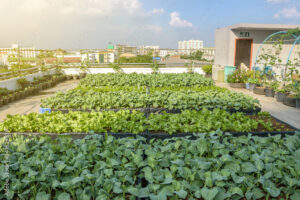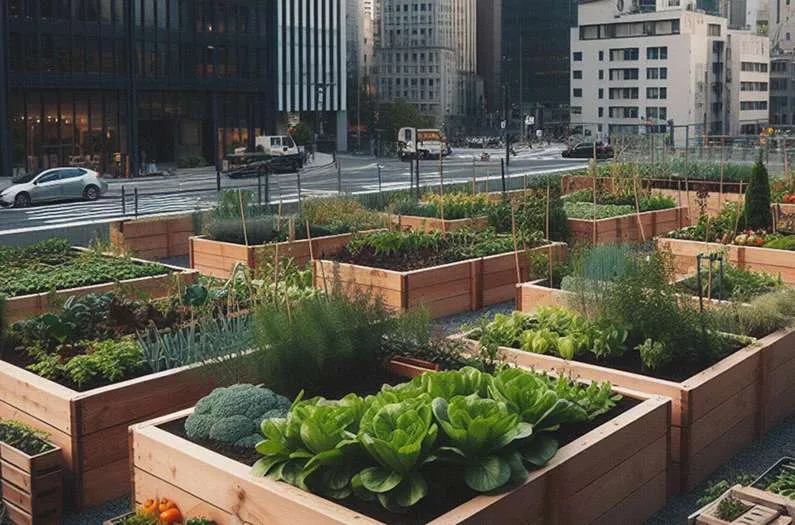Introduction
Urban gardening, the practice of cultivating, processing, and distributing food in or around urban areas, has seen a resurgence in popularity in recent years. This revival can be attributed to several factors, including the increasing awareness of food security, the desire for fresher and more organic produce, and the therapeutic benefits of gardening. With the challenges of limited space, urban gardeners have developed innovative techniques to grow food in small spaces, turning balconies, rooftops, windowsills, and even walls into productive green areas.
The Benefits of Urban Gardening
Urban gardening offers a myriad of benefits, both personal and societal. Here are some of the most significant advantages:
Food Security and Freshness: Urban gardening can enhance food security by providing a direct source of fresh produce. This is especially important in food deserts, where access to fresh fruits and vegetables is limited.
Environmental Impact: Growing food in urban areas can reduce the carbon footprint associated with transporting food from rural areas to cities. Additionally, urban gardens can improve air quality, reduce urban heat islands, and promote biodiversity.
Health and Well-being: Gardening is a physical activity that can improve physical health and reduce stress. The presence of green spaces also has a positive impact on mental health, providing a sense of accomplishment and tranquility.
Community Building: Urban gardens can strengthen community bonds by bringing people together. Community gardens often become social hubs where neighbors can interact, share resources, and collaborate on projects.
Education: Urban gardening offers educational opportunities for people of all ages. It teaches children about nature, ecology, and the origins of their food, while adults can learn sustainable practices and new skills.
Challenges of Urban Gardening
While urban gardening offers numerous benefits, it also comes with its own set of challenges:
Space Constraints: The most obvious challenge is the limited space available in urban settings. Gardeners must be creative in utilizing every inch of available space.
Soil Quality: Urban soil can be contaminated with pollutants, making it unsuitable for gardening. Container gardening and raised beds are often necessary to ensure clean, healthy soil.
Sunlight: Tall buildings can block sunlight, making it difficult to find spots with adequate sunlight for plants. Understanding the light requirements of different plants and strategic placement is crucial.
Water Access: Consistent access to water can be an issue, especially in areas with water restrictions. Efficient watering systems and drought-resistant plants can help mitigate this challenge.
Pests and Diseases: Urban areas have their own set of pests and diseases that can affect plants. Integrated pest management (IPM) practices are essential to keep plants healthy.
Types of Urban Gardening
Urban gardening encompasses various techniques and approaches, each suitable for different spaces and needs. Here are some popular types of urban gardening:
Container Gardening: This involves growing plants in pots, buckets, or other containers. It is ideal for balconies, patios, and other small spaces. Containers can be moved around to take advantage of sunlight and are easy to manage.
Raised Beds: Raised beds are elevated garden plots that provide better control over soil quality and drainage. They are particularly useful in areas with poor soil conditions and can be constructed in various shapes and sizes.
Vertical Gardening: Vertical gardening maximizes space by growing plants upward instead of outward. This can be done using trellises, hanging planters, wall-mounted pots, and hydroponic systems. Vertical gardens are perfect for small spaces like balconies and narrow walkways.
Hydroponics and Aquaponics: These soilless gardening methods use nutrient-rich water to grow plants. Hydroponics involves growing plants in water with dissolved nutrients, while aquaponics combines fish farming with hydroponics, using fish waste as a nutrient source for the plants. Both methods are space-efficient and can be set up indoors or outdoors.
Rooftop Gardens: Rooftop gardens transform underutilized roof space into productive green areas. They can range from simple container gardens to elaborate green roofs with soil layers and irrigation systems. Rooftop gardens can provide insulation, reduce stormwater runoff, and offer a pleasant retreat in urban environments.
Community Gardens: Community gardens are shared spaces where people come together to grow food. These gardens often occupy vacant lots or designated areas in parks and can foster a sense of community, provide educational opportunities, and increase food security.
Planning Your Urban Garden
Successful urban gardening requires careful planning and consideration of various factors:
Assess Your Space: Evaluate the available space for gardening. Measure the dimensions, observe the amount of sunlight it receives, and identify any potential obstacles or limitations.
Choose the Right Plants: Select plants that are well-suited to your space, climate, and available sunlight. Consider the growth habits, size, and maintenance requirements of different plants. Leafy greens, herbs, and compact vegetables are often good choices for small spaces.
Soil and Containers: If you’re using containers, choose ones that are appropriate for the plants you intend to grow. Ensure good drainage and use high-quality potting soil. For raised beds, fill them with a mix of garden soil, compost, and other organic matter.
Watering System: Establish a reliable watering system. Drip irrigation, self-watering containers, and rainwater harvesting can help ensure your plants receive consistent moisture.
Pest Management: Implement integrated pest management (IPM) practices to keep pests and diseases at bay. This includes using natural predators, companion planting, and organic pest control methods.
Maintenance and Care: Regularly monitor your garden for signs of stress, disease, or nutrient deficiencies. Prune, fertilize, and provide support for plants as needed. Consistent care will help ensure a healthy and productive garden.
Urban Gardening Techniques and Tips
Maximize Vertical Space: Use trellises, hanging planters, and vertical gardens to make the most of limited space. Plants like tomatoes, cucumbers, beans, and peas can be trained to grow vertically.
Succession Planting: Practice succession planting to make efficient use of your garden space. This involves planting a new crop as soon as one is harvested, ensuring a continuous supply of fresh produce.
Companion Planting: Grow plants that benefit each other together. For example, plant basil with tomatoes to repel pests, or grow marigolds to deter nematodes.
Use Dwarf and Compact Varieties: Choose dwarf or compact varieties of plants that are bred for small spaces. These plants are often more manageable and require less space to grow.
Herb Spirals: Create a herb spiral to grow a variety of herbs in a small area. This design maximizes space and creates microclimates that suit different types of herbs.
Microgreens and Sprouts: Grow microgreens and sprouts indoors. They are quick to grow, packed with nutrients, and require very little space.
Windowsill Gardening: Utilize sunny windowsills to grow herbs, greens, and small vegetables. Use small pots or trays and ensure they receive adequate light.
Mulching: Use mulch to retain moisture, suppress weeds, and improve soil health. Organic mulches like straw, wood chips, and compost are excellent choices.
Rainwater Harvesting: Collect rainwater to reduce your dependence on municipal water sources. Use rain barrels or other collection systems to capture and store rainwater for irrigation.
Worm Composting: Set up a worm composting system (vermicomposting) to recycle kitchen scraps into nutrient-rich compost. Worm composting is ideal for small spaces and provides a steady supply of organic fertilizer.
Case Studies and Success Stories
New York City’s Rooftop Farms: Brooklyn Grange is one of the largest rooftop farming enterprises in New York City. With over 2.5 acres of rooftop space, they grow a variety of vegetables, herbs, and flowers, providing fresh produce to local markets and restaurants. The farm also offers educational programs and community events.
Singapore’s Sky Greens: Sky Greens is the world’s first low-carbon, hydraulic-driven vertical farm. Located in Singapore, this innovative farm uses rotating towers to maximize sunlight and space, producing a variety of leafy greens. The vertical farming system significantly reduces water and energy consumption.
Detroit’s Urban Farms: Detroit has become a hub for urban farming, with numerous community gardens and urban farms transforming vacant lots into productive spaces. The Michigan Urban Farming Initiative (MUFI) is a notable example, providing fresh produce to local residents and fostering community engagement.
London’s Growing Communities: Growing Communities is a community-led organization in London that runs urban market gardens, a farmers’ market, and a veg box scheme. They focus on sustainable and organic farming practices, providing fresh produce to the local community and promoting food sovereignty.
Conclusion
Urban gardening is a powerful movement that brings numerous benefits to individuals and communities. By creatively utilizing small spaces and adopting sustainable practices, urban gardeners can grow fresh, healthy food while contributing to environmental sustainability and community well-being. Whether you have a tiny balcony or a rooftop, there are countless ways to get started with urban gardening. With careful planning, dedication, and a bit of creativity, anyone can become an urban gardener and enjoy the rewards of growing their own food in the heart of the city.








Leave a Reply